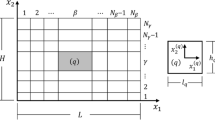Abstract.
We determined the total system elastic Helmholtz free energy, under the constraints of constant temperature and volume, for systems comprised of one or more perfectly bonded hard spherical inclusions (i.e. “hard spheres”) embedded in a finite spherical elastic solid. Dirichlet boundary conditions were applied both at the surface(s) of the hard spheres, and at the outer surface of the elastic solid. The boundary conditions at the surface of the spheres were used to describe the rigid displacements of the spheres, relative to their initial location(s) in the unstressed initial state. These displacements, together with the initial positions, provided the final shape of the strained elastic solid. The boundary conditions at the outer surface of the elastic medium were used to ensure constancy of the system volume. We determined the strain and stress tensors numerically, using a method that combines the Neuber-Papkovich spherical harmonic decomposition, the Schwartz alternating method, and Least-squares for determining the spherical harmonic expansion coefficients. The total system elastic Helmholtz free energy was determined by numerically integrating the elastic Helmholtz free energy density over the volume of the elastic solid, either by a quadrature, or a Monte Carlo method, or both. Depending on the initial position of the hard sphere(s) (or equivalently, the shape of the un-deformed stress-free elastic solid), and the displacements, either stationary or non-stationary Helmholtz free energy minima were found. The non-stationary minima, which involved the hard spheres nearly in contact with one another, corresponded to lower Helmholtz free energies, than did the stationary minima, for which the hard spheres were further away from one another.
Graphical abstract

Similar content being viewed by others
References
A.E.H. Love, A treatise on the mathematical theory of elasticity, 2nd edition (Cambridge University Press, 1906)
S.P. Timoshenko, J.M. Gere, Theory of elastic stability, 2nd edition (McGraw-Hill, 1963)
L.D. Landau, E.M. Lifshitz, Course of Theoretical Physics: Elasticity Theory (Pergamon Press, 1989)
A.S. Saada, Elasticity: Theory and applications, 2nd edition (J. Ross Publishing, 2009)
M.F. Beatty, J. Elast. 104, 71 (2011)
M. Ameen, Computational elasticity: theory of elasticity, finite and boundary element methods (Alpha Science International, 2004)
H.R. Sadraie, S.L. Crouch, Comput. Mech. 37, 60 (2005)
H.R. Sadraie, S.L. Crouch, S.G. Mogilevskaya, Eng. Anal. Bound. Elem. 31, 425 (2007)
T.W. Ting, J.C.M. Li, Phys. Rev. 106, 1165 (1957)
T.H.K. Barron, R.W. Munn, Pure Appl. Chem. 22, 527 (1970)
A.G. McLellan, The classical thermodynamics of deformable materials (Cambridge University Press, 1980)
J.J.W. Morris, Course notes: Thermodynamics and phase transformations, http://www.mse.berkeley.edu/groups/morris/MSE205/Extras/Elastic.pdf
A. Mundy, J. Fitzpatrick (Editors), The Scientific Basis of Urology, 3rd edition (CRC Press, 2010)
J. Baumann, B. Affolter, World J. Nephrol. 3, 256 (2014)
D.R. Basavaraj, C.S. Biyani, A. Browning, J.J. Cartledge, European Association of Urorlogy and European Board of Urology, EAU-EBU Update Series 5, 126 (2007)
A.R. Izatulina, Y.O. Punin, O.A. Golovanova, J. Struct. Chem. 55, 1225 (2014)
S. Goldman, J. Chem. Phys. 132, 164509 (2010)
A.I. Lur’e, D.B. McVean, J.R.M. Radok, Three dimensional problems of the theory of elasticity (John Wiley and Sons, Ltd., 1964)
P.F. Papkovich, C. R. Acad. Sci. 195, 513 (1932)
H. Neuber, ZAMM-Z Angew. Math. Me. 14, 203 (1934)
W.H. Press, B.P. Flannery, S.A. Teukolski, W. Vetterling, Numerical Recipes, The art of Scientific Computing (FORTRAN version) (Cambridge University Press, 1989)
S. Timoshenko, J.N. Goodier, Theory of Elasticity (McGraw-Hill, 1951).
G.B. Arfken, H.J. Weber, Mathematical methods for physicists, 6th edition (Elsevier Inc., 2005)
I. Jankovic, High-order analytic elements in modeling groundwater flow, Ph.D. thesis, University of Minnesota, Minneapolis (1997)
E.A. Guggenheim, Thermodynamics - An advanced Treatment for Chemists and Physicists (North-Holland, 1967)
J.M. Solano-Altamirano, J.D. Malcolm, S. Goldman, Soft Matter 11, 202 (2015)
Author information
Authors and Affiliations
Corresponding author
Electronic supplementary material
Rights and permissions
About this article
Cite this article
Solano-Altamirano, J.M., Goldman, S. Thermodynamic stability in elastic systems: Hard spheres embedded in a finite spherical elastic solid. Eur. Phys. J. E 38, 133 (2015). https://doi.org/10.1140/epje/i2015-15133-1
Received:
Accepted:
Published:
DOI: https://doi.org/10.1140/epje/i2015-15133-1




